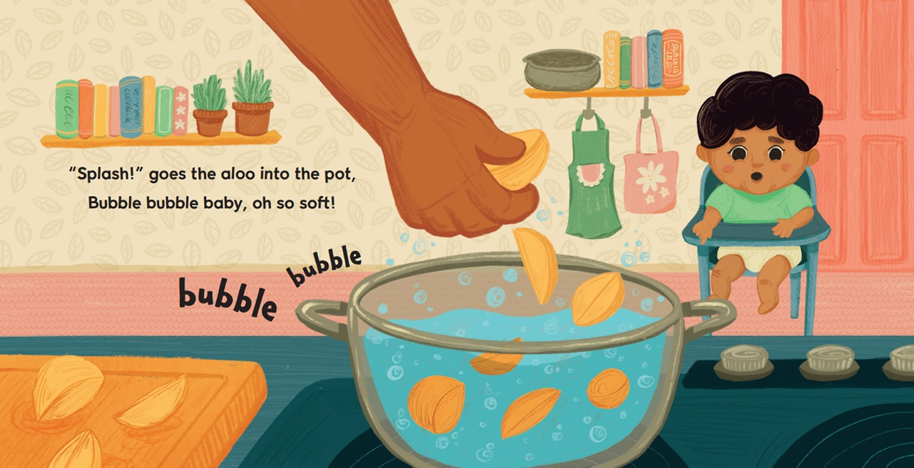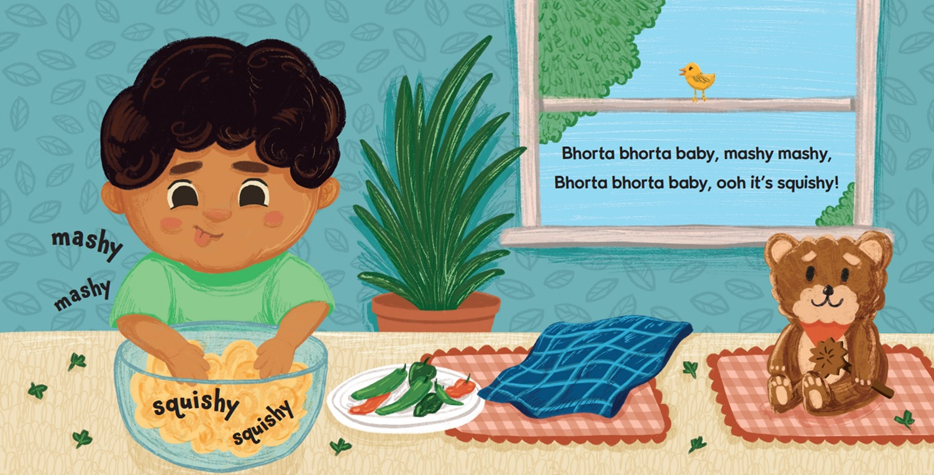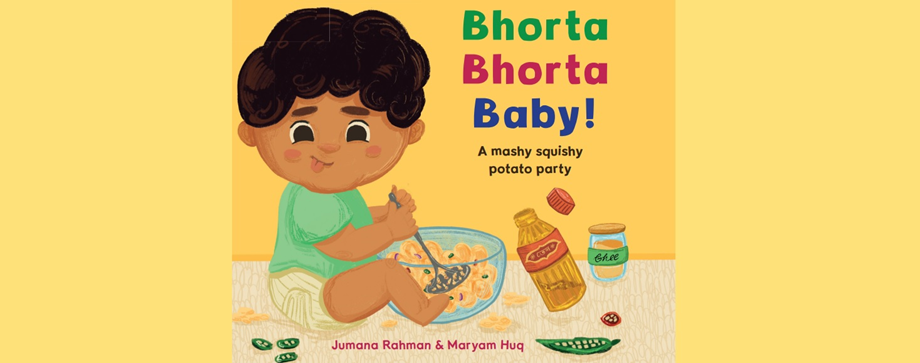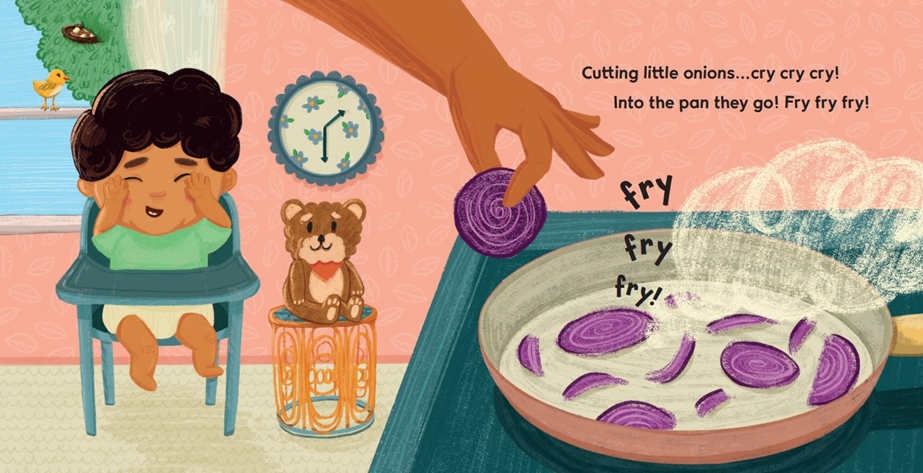Jumana Rahman


About Author
Jumana Nikita Rahman is a self-proclaimed "fun mom" and learned to ride a bike very late in life just to prove to her son she could. Though she doesn't take herself too seriously, she prioritises sharing her Bangladeshi-Canadian upbringing with the next generation of third culture kids. Jumana lives with her husband and son in Ontario, Canada. Instagram: @jumanarahmanauthor
Maryam Huq is a UK-based digital artist known for her vibrant, whimsical style featuring bold colour choices and striking imagery. She portrays themes of nostalgia and a sense of belonging in her work, stemming from her personal experiences of re-connecting with Bangladeshi culture and her heritage. Instagram @vividbymaryam
Interview
Bhorta Bhorta Baby! (Bok Bok Books)
November 2023
Celebrate this classic Bangladeshi dish with young children through this lively rhyming story, written by Jumana Rahman and illustrated by Maryam Huq, in which we follow the steps for making bhorta.
Bhorta Bhorta Baby (Bok Bok Books) is a playful story, ideal for sharing with very young children. Author and mum Jumana tells us more about her inspiration for this story, and shares part of the story with us in her video, as well as highlighting the importance of sharing and celebrating unique cultural moments like this with children in her Q&A for ReadingZone.
Q&A with Jumana Rahman
"I think it's so important to reflect on how our simple traditions bring us joy and to think about
how we can make them our own as we grow our own young families."
1. Thank you so much for joining us on ReadingZone, Jumana. Can you tell us a little about yourself and how you became involved in writing books for very young children?
Writing short stories and poems had been something I loved to do as I was growing up. But once there were babies in the family, my nephew, Azan, and my own son, Kitaab, writing poems and stories for them, coming up with goofy songs would just flow right out of me.
2. What is your new book, Bhorta Bhorta Baby!, about, and what gave you the idea for the story?
So bhorta is a basically a mash; made of boiled or roasted veggies, salt, mustard oil, chilies and onions. Whether its made of classic potato, beans, fish, egg, lentils, eggplant, or even poppy seed... It's always mouthwatering and delightful to eat with a steaming hot plate of rice and a dollop of ghee on top. It just feels like home.
The idea came about when my husband and I would play this game with our nephew when he was very little and round. We would essentially tickle and squish him and tell him we're making him into mashed potatoes. Making bhorta itself is a process that requires a lot of mashing down the ingredients by hand. For us, tickling and wiggling our round little nephew was always hilarious. His little belly, his little elbows! It was the greatest. A tickle-fest. A way to get his giggles out and physically play, all while calling on this classic Bangladeshi comfort food.
3. As you say, the bhorta recipe at the heart of the story is from Bangladesh; why did you want to share this particular recipe?
Bhorta is meant to be humble, made of staples found in the home and a way to curb food waste. But as casual as it is, it can also be made in quite fancy ways and using rare ingredients. Bhorta is also eaten a lot on festivals and Bengali New Year. It's also a large part of doting on a mom-to-be at her baby shower, too.
No matter where in the world a Bangali goes, it's likely they'll make bhorta, rice and daal when they get there. Bhorta personally feels emblematic of identity as a Bangladeshi person living outside of Bangladesh too. I'm a mash-up of cultures and traditions that make me who I am.

4. Why is it important for you to share these cultural moments, both within and outside communities, through stories like Bhorta Bhorta Baby?
I think it's so important to reflect on how our simple traditions bring us joy and to think about how we can make them our own as we grow our own young families. Babies and their caregivers alike are looking for something to connect over. Comfort. Tradition. Culture. General cuteness. It's really quite simple; stories like Bhorta Bhorta Baby are about families sharing a moment together.
5. Is cooking also family time for you? Do you enjoy sharing a kitchen with very young children?
Oh yes, cooking up eggs for breakfast, baking, or meal prepping for the week... My son, Kitaab, age 3, is always hovering and asking to help. Even when I'm done cooking, playtime on the family room rug consists of cooking with his little pots and pans play set all over again!
6. Why did you want to focus on an everyday family activity in this story?
It's so nice to see a process come to life. The separate ingredients each taking on their role. Bringing pieces together to work as a delicious team. The sensation of musical sounds in the kitchen and the feel of squishy mashed potatoes within your hands... It's about seeing the special moments in our very ordinary day-to-day.

7. How have you written the text to appeal to young children and to create a shared moment with an adult?
It's quite a short and bouncy poem using very simple language. There's a certain rhythm and close rhyme used in the poem that I hope will have young ones pulling the book of their shelf to read again and again with their families.
8. What do you feel that Maryam's illustrations have brought to your text? Did you enjoy seeing the final copies?
Maryam's illustrations brought such immense joy to my heart. They are vivid and incredibly detailed in the textures and token Bangali touches here and there. From the bird in the window, to the cookbook on the shelf... The main character is a beautiful representation of any happy child hungry to eat something yummy. I was so pleased to see each page more incredible than the last.
9. How is the Bangladeshi community responding to Bhorta Bhorta Baby!? Do you have plans to publish more stories for young children sharing other recipes or cultural highlights?
The community sure loves Bhorta! The response has been that people are surprised there hasn't been a book about Bhorta put out earlier! I think it's also quite fresh that Bhorta Bhorta Baby is geared at the youngest, littlest members of our community: babies. Babies deserve representation in their literature too! Haha.

Q&A with Maryam Huq, illustrator
"Most of my pieces are inspired by my heritage and culture."
1. Hello Maryam, thank you so much for joining us on ReadingZone. Can you tell us how you became an illustrator, and started illustrating books for children?
I'm a 27 year old British-Bangladeshi and I started my illustration journey under the name VividByMaryam back in 2020. I have a background in the sciences, but when the pandemic hit I found myself jobless and in a foreign place (I was living in Canada at the time), so decided to spend some time working on things I loved to do. Having left all my art materials back in the UK, this eventually led to me teaching myself how to illustrate digitally.
I hadn't considered drawing for picture books until Jumana contacted me back in July 2022 to ask if I might be interested in working on her book. Bhorta Bhorta Baby! is the first cover to cover book I've had the pleasure of illustrating, and I can't wait to work on more in the future!
2. How would you describe your style of illustration?
I'm primarily a digital illustrator and would say that my style tends to be made up of bright, saturated colours and a range of textures to add a sort of vintage feel. I like to use interesting perspectives and compositions to add an element of fantasy to the environments I draw inspiration from, based on photographs I've taken on my travels back home.
3. What kinds of stories do you enjoy illustrating and why did you want to illustrate Bhorta Bhorta Baby!?
Most of my pieces are inspired by my heritage and culture, so when Jumana approached me with a children's poem she'd written about making bhorta, a well-loved Bangladeshi food staple, it was an absolute no-brainer! The book is so much fun for both children and adults, we've even thrown in some Easter eggs that some people may recognise from their own childhoods. I've not illustrated for this age range before, so I was really excited to apply my style in a different way.
3. How did you approach illustrating this story, and how have you made the images so child-centred and full of joy?
The illustrations for the story were very much a collaborative effort, between myself, Jumana, Rumana from Bok Bok Books and Clare Baggely, our art director. We had plenty of phone calls, drafted lots of presentations and made a number of tweaks along the way to get everything just right.
We took lots of inspiration from the children in our lives, as well as the upbeat energy from the text itself to help us fill the pages with excitement and vibrancy for the readers to enjoy. We added 'Teddy' in slightly later, but I definitely think the story has benefitted from having the additional cooking companion on each page!

4. What were the challenges in creating the illustrations for this story? Which spread are you happiest with?
As this was my first picture book, I certainly encountered a few challenges along the way and learned a lot from the process. For example, I somewhat underestimated the time and effort that would go into producing a short baby board book; it's been roughly a year and a half between starting and launching the final product.
Character development is also quite a new concept for me, so I purchased a few books and resources to help me with drafting our two main characters. Funnily enough, drawing babies has been quite a logistical challenge as their body proportions differ hugely from adults, who I'm much more used to drawing.
All in all, I'm so grateful for the incredible experience this has given me and everything I've learned along the way. I think the spread I'm most happy with is on pages 5-6, where the onions are frying away in the pan and we have all of our characters featured throughout the spread.
5. Can you tell us a bit more about how you create your images?
After completing the initial sketches, I get to work to clean them up and make sure we're ready to add colour. Thumbnailing really helps with this as you can try lots of colour combinations first to see what works best. Once the base colours have been added, I'll get to work on adding all the details and textures to create the final look. I normally work on a Procreate, but because each spread consisted of so many elements, I also had to teach myself to work on Photoshop to make the process more efficient.
6. Where do you prefer to work? And where do you go for inspiration?
I work from home most of the time and share an office space with my dad. But my side of the room is definitely more colourful (and messy!), as I've stuck up lots of artwork and have shelves of paper and art materials lining the wall. When I feel a bit overwhelmed or distracted, I'll go to a local coffee shop and sit there for a while and listen to podcasts while I work.
It might be a little cliched, but I'm inspired hugely by my travels and when I return home I often spend time looking over photos I've taken when visiting new places. But when travelling isn't possible, I often enjoy taking a trip to one of the many museums and galleries available in London.
7. Do you have other projects coming up?
As we approach the end of the year, I'm winding down on a lot of projects and personal commissions, whilst trying to plan ahead for the next 12 months. Throughout the year I usually design and illustrate prints and stationery for my personal shop, so I'm aiming to work on a new collection for spring. At the moment, 2024 is an open book but I hope to stay open to opportunities and see where the wind takes me!
8. What do you enjoy doing when you're not in your studio? What are your favourite escapes?
When I want to take some time out from work, I like to see friends, head to the gym or watch my favourite sitcoms on repeat. If I have a whole day free, I'll create a whole itinerary to keep me outside for as long as possible so I can come back refreshed and not feel tempted to start anything new that day.
My last field trip was a visit to the National Gallery, with a stop for lunch at Chinatown near Tottenham Court Road. Previously art was my escape, but now that it's become my full-time job I try to preserve the creativity for when I sit down at my desk to work on new things.
 Bhorta Bhorta Baby
Bhorta Bhorta Baby
